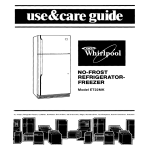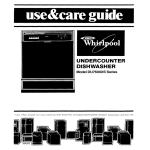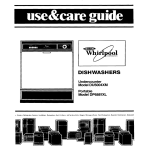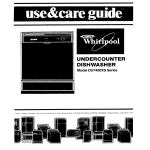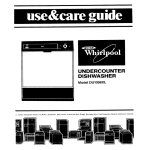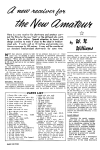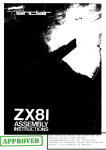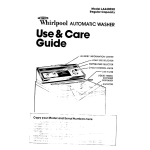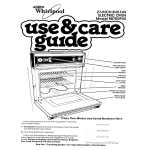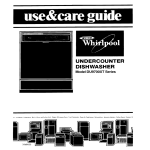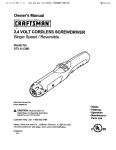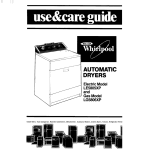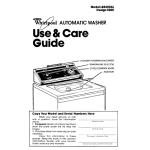Download Whirlpool DU1800XT Specifications
Transcript
UNDERCOUNTER DISHWASHER Model DU1800XT freezers. Refrigerator Freezers Ice Makers DIshwashers. Bu~lt~ln Ovens and Surface Units. Ranges Microwave Ovens Trash Compactors. Room Air Candltloners, Oehumidl Contents Page Before You Use Your Dishwasher Important Safety Instructions. Parts and Features.. For Best Results Preparing the load for washing Water must be hot Quiet operating tips Proper loading,, Top rack loading Bottom rack loading Silverware basket loading.. Adding Detergent.. Before Starting Your Dishwasher. Starting Your Dishwasher Changing a setting Selecting a cycle HEAT DRY or AIR DRY? To add a dish after starting Energy Saving Tips.. Special Tips on Dishwasher Use Common Dishwashing Problems.. If You Need Service or Assistance. Whirlpool Dishwasher Warranty 01989 Whirlpool B Corporation Before you use your dishwasher It is your responsibility and to be sure your dishwasher: Is installed by a qualified installer. l Has been installed where it is protected from the elements. l Has been installed on a floor strong enough to support its weight. l Has been properly connected to electricity, water and drain.* l Has been properly electrically grounded.* l Has had all hang tags and temporary labels removed. l Is not used by children or anyone unable to operate it properly. l Is properly maintained. l *See Installation Instructions for complete information. Important safety instructions Read all instructions before using the dishwasher. . DISHWASHER MUST BE ELECTRICALLY GROUNDED. Read the Installation Instructions for details. l Be sure your dishwasher is installed on a level floor that will hold the weight, and in an area suitable for its size and use. l When discarding an old dishwasher, always remove the door to prevent accidental entrapment. l REMEMBER, use your dishwasher only for the job it was designed to do. l Store dishwasher detergent in a cool, dry place WHERE CHILDREN CAN’T REACH IT. l Use ONLY detergents and rinse aids recommended for use in a dishwasher. l Locate sharp items and knives so that they are not likely to damage door seal or cut the user. l DO NOT let children play in or on the dishwasher. l DO NOT reach into the area below the bottom rack until the heating element has cooled for at least 20 minutes. l DO NOT wash plastic items unless marked “Dishwasher Safe” or the equivalent. If not marked, check manufacturer’s recommendations. l DO NOT use your dishwasher unless all enclosure panels are properly in place. l DO NOT sit on, stand on or abuse the dishwasher door or dish racks. l DO NOT tamper with controls. l If hot water has not been used recently (usually two weeks or longer), hydrogen gases may build up in the water heater and the hot water pipes. HYDROGEN GAS IS EXPLOSIVE. To prevent injury or damage, before using your dishwasher, turn on all hot water faucets and allow water to run for several minutes. This will allow gases to escape. Do not smoke or use any open flame near the faucet while it is open. l Disconnect electrical power to the dishwasher before attempting to service. - SAVE THESE INSTRUCTIONS l Parts and features Model DUl800XT MODEL AND SERIAL NUMBER PLATE [not shown) TOP RACK \ / SILVERWARE BASKET Ii.. BOTTOM RACK CENTER WASH TOWER (not shown) II THE OVERFLOW PROTECTOR is designed to prevent too much water from entering the dishwasher It must be in place when the dishwasher is run. SPRAY ARM (not shown) DETERGENT DISfjENSERS / y DOOR PANEL - 3 COLOR OPTIONS DOOR LATCH. [not ihown) HEATING ELEMENT Than& tration ~0” tc bbying Card arovlded “(‘ij,, . ,_ r,: .l)i -I,,;- 1,y.s -1 .- i‘.lt:,a “,:Jp:: d Q Wl-+lrlpool appliance. with this product.‘hen : :- (: ,. ‘t- :t 1 [ Please ..-. ,i,.A_f. ,‘; tj \ ,,: and the Owner RegisHave this information mail the form below ,-011 ,dl+rl 0 question r IbeT f‘3n plate (see i3se 3: lte from jales ,j,F: o Ksp!~ complete complete :>‘- . ;: tog-Aver -~-Model Number Serial Number I ti hardy Purchase Service Date Company Phone Number For best results Your dishwasher cleans by spraying a mixture of hot, clean water and detergent against soiled surfaces of dishes. When a cycle is started, the dishwasher fills with water to a level slightly above the heating element. This water is constantly pumped through the rotating spray arm and center wash tower onto the dishes. Soiled water is pumped out and replaced with clean water during a cycle. The number of times depends on the cycle being used. Loud dishes so soiled surfaces face the powerful spray from rotating arm and center wash tower. Preparing the load for washing It is not necessary to rinse dishes before putting them dishwasher. Just remove large pieces and quantities and bones. Foods that are burned onto utensils (not just on] may be difficult to remove. Some hand washing necessary into the of food cooked may be Water must be hot 140 F Cl For best cleaning and drying results, water should be at least 140-F (60 C]. 1. Turn on hot water faucet nearest the dishwasher. Let water run until It IS as hot as possible 2. Hold a candy or meat thermometer in the stream of hot water to measure the temperature 3. If the temperature is too low, have a qualified person raise the water heater thermostat setting Check Water Temperature Quiet operating tips To avoid thumping and clattering noises during operation: Make sure lightweight load items are secured in the rack. l Make sure pot lids and handles, pizza pans, cookie sheets, etc. do not touch interior walls or intlerfere with the spray arm rotation and center wash tower extension. l Load dishes so they don’t touch one another. NOTE: Keep sink drain plugs inserted during dishwasher operation to prevent noise transfer through drains. l Proper loading Always load dishes so soiled surfaces are reached wash tower. Water must be able to drain off completely Items so spray can reach all surfaces. Top rack by spray from rotating arm and center for best results. Be careful to separate loading (. UP AND GLASS LOAD The top rack IS desrgned for cups, glasses and smaller items. Place so open ends face down for cleaning and draining. load glasses in top rack only. Bottom rack is not designed for glasses. Damage may occur. Place items in the rows between prongs. Placing them over the prongs can lead to breakage Be sure lightweight items are held firmly In place. l China, crystal and other delicate items must not touch each other during dishwasher operation. Damage may occur. UTENSIL LOAD MIXED LOAD l l l l Load plastic items only in the top rack Only plastic items marked “Dishwasher Safe” are recommended. Load plastic items so the force of the spray does no+ move them during the cycle Plastic items can be melted ;n the bottom rack Items w rh cookea-on solled surfaces facing or dried-on the spray foods l Small bowls, pans and other utensils can be placed In the top rack. should be loaded In the bottom rack with Bottom rack loading DISH LOAD MIXED LOAD ii’\ \ ‘1 l l l Make sure pot handles and other items do not stop rotation of the lower spray arm or block the center wash tower from extending upwards. Load cookie sheets, cake pans and other large items at the sides. Securely place heavily soiled cookware face down in rack NOTE: Do not load glasses, cups or plastic Items in the bottom rack. l When lower rack is removed, replace with bumpers in front. l Place plates, soup bowls, etc. prongs and facing the spray SilwrMare between basket loading l Do not center i.oaa the silverware basket while ifs in or out of the bottorri rack The loaded basket should oe in the center back of the bottom rack Load forks an4 spoons 50 they don’t nest together. Spray can’i reach nested Items MIX Item> in each section of the basket with some pointing up and some down. Small Iterns - baby bottle caps jar IIds etc - can be put In any section Do not block the center area of the bottom rack when loading. The center wash tower extends through this area. Blockage may result in poor cleaning. Personal Safety Hazard To avoid cuts from sharp items (knives, forks, skewers, etc.), make sure these items are put in point down. Adding detergent The kind and amount of dishwasher detergent you use IS an Important getting L’our dishes clean Read this sectlon carefully Use automatic washer detergent 1 The detergent dispenser dishonly. The detergent dispenser has four cups. Cups 2 and 4 hold detergent for the first wash. The covered cups 1 and 3 hold detergent for the second wash. . To open or close the covered cups, grasp the tabs and pull or push. After filling, close the cups before shutting the dishwasher door. The covered cups open automatically when the main wash starts. Detergent in the open cups falls into the dishwasher when me door is closed. Other detergents are too mild and much too sudsy to work in the dishwasher. Different brands of dishwasher detergent have different amounts of phosphorus. Phosphorus softens water and helps prevent water spots on dishes If water is hard and IS phosphorus content low (6.04, or less], you may need to use more detergent or use a brand with a higher phosphorus content (8.7% or higher) Do not add detergent until you are ready to wash. Fresh automatic dishwasher detergent is necessary for best washing results. Store detergent tightly closed In a cool dry place How much part of [ OPEN CUPS COVERED CUPS I Use all cups for... NORMAL WASH Cycle detergent Use covered cups for... LIGHT WASH Cycle to use The amount ot detergent to use depends on t’le hardness of your water If too little IS used dishes wont be clean However. if too much IS used In soft water, glassware WIIJ begin to etch Find out you: water’s hardness by asking your S~cal water department, water splftener company or county extensl,3n agent Detergent chart CYCLE WATER HARDNESS (Grains SOFT (O-4 grains) NORMAL WASh LIGHT WASH l.. Per Gallon) MEDIUM (5-8 grains] HARD TO VERY HARD (over 8 grains) ‘2 tablespoon all cups. in Half fill all cups. Fill all cups. j 2 tablespoon each covered in cup. Half fill each covered cup. Fill each covered cup. Drying Option Selects 3r Switcl h Before starting your dishwasher 1. Spin the Lower Spray Arm to make sure nothing will stop it from turning freely 2. Be sure nothing blocks the center area in the bottom rack. The center wash tower extends through this area during the cycle. Starting 3. Run hot water at sink nearest dishwasher until it is hot, then turn it off. 4. If you have a disposal in the sink, run it to clear any food scraps, then turn it off. This will insure good drainage. your dishwasher Wb” A . ,,GH. 9) NORMAL WASH Cycle... 1. Select a drying option. 2. Turn the Cycle Control Knob so that it points to NORMAL WASH. 3. Latch the door to start the cycle. LIGHT WASH Cycle... RINSE & HOLD Cycle... 1. Select a drying option. 2. Turn Cycle Control Knob until it points to LIGHT WASH. 3. Latch the door to start the cycle. 1. Select AIR DRY Option only. 2. Turn the Cycle Control Knob clockwise until it points to RINSE & HOLD. 3. Latch the door to start the cycle. Changing a setting You can change a setting anytime during any cycle. 1. Unlatch the door to stop the cycle. 2. Turn the Cycle Control Knob clockwise to the cycle you want. 3. Be sure the detergent dispensers properly for the new cycle. 4. Latch the door to start the cycle. are filled ‘Cl e Cor itrol Knob . Selecting a cycle Door latch-After closing tlhe door, move door latch all the way to the righi ‘. TIiis lot :ks the door and turns on the dishwasher NORMAL WASH Cycle A double wash for normal to heavily soiled loads. (The Energy Guide Label data is based on this cycle.) Cycle time is about 70 minutes. LIGHT WASH Cycle For lightly soiled or pre-rinsed loads. Cycle time is about 60 minutes. RINSE & HOLD Cycle For rinsing a few items to be washed one or more days later. Cycle time is about 15 minutes. Use AIR DRY only. HEAT DRY or AIR DRY? If the HEAT DRY Option is selected, air In the dishwasher is heated during the “dry” part of the cycle. If the AIR DRY Option is selected, air in the dishwasher is not heated. Using this option helps save energy, but dishes take longerto dry [overnight] and some water spotting may result To add a dish after starting 1. To be sure the added item is washed and rinsed, make sure the Cycle Control Knob has not passed LIGHT WASH. 2. Unlatch the door to stop the cycle, but don’t open it until the spray arm stops spinning. 3. Open the door and add the dish. Some Items (such as plastics) drying may need towel 4. Close the door. Do not latch it. Wait 30 seconds for air in the dishwasher to warm up. This helps reduce theamountofmoisturethatcan come from the vent when restarting the cycle. 5. Latch the door. The dishwasher will start from where it stopped. 9 Energy saving tips You can help save energy if you: 1. Wash full loads. Runnrng o half-filled dishwasher uses the same amount of electrrcity and hot water as a fully loaded machine 2. Use the LIGHT WASH Cycle for moderately soiled loads. It uses less hot water and energy than NORMAL WASH. 3. Air dry dishes drying cycle. [overnight). 4. Load correctly for best washing results. Incorrect loading may cause poor washing and the need to rewash all or part of the load when you don’t need a rapid Allow longer drying times 5. Don’t pre-rinse normally soiled dishes. Select the correct cycle for the load and use the recommended amount of detergent for good washing results without hand rinsing. 6. Use your dishwasher during off-peak hours. Local utillties recommend this to ovoid heavy usage of energy at certain times of dav can be done quickly and 7. Kitchen cleanup efficiently through the use of yourdishwasher. Most appliance parts that can fit in the dishwasher can be cleaned by it. Burned-on soil, however, should be cleaned by hand. 10 Special tips on dishwasher use Remember, use your dishwasher only for the job it was designed to do. Some items are not dishwasher safe or may require special care. Read these special tips for the following items: .~UIlIinUIn: Aluminum loses its bright, shiny appearance and darkens in color due to minerals the water and the alkalinity of the dishwasher detergent. Colored aluminum may fade. in TIPS: If washed in the dishwasher avoid placing directly in front of detergent dispenser where it could be sprinkled with undissolved detergent, causing spotting, pitting, and discoloration. Follow utensil manufacturers’ cleaning instructions. China: Hand-painted, metal-trimmed, and antique china fade due to high water temperatures and alkaline detergent solution In the dishwasher. NOTE: Delicate, antique items should not be washed in the dishwasher. TIPS: Load china carefully. Do not allow pieces to touch each other. Test one piece by washing it daily in the dishwasher for several weeks. Then compare it with the rest of the set to see if colors have changed Crystal and decorative glasses: temperature. dishwasher Crystal can break from sudden exposure to high water Metal trim and colorful decoration on glass will fade in time when washed in the NOTE: Delicate, antique items should not be washed in the dishwasher. TIPS: Load crystal carefully in top rack only. Be sure to load a few larger items in the bottom rack f0 reduce amount of force of water spray reaching glassware from lower spray arm. Use the shortest cyc:le Flafiyare: Salty and acidrc foods may tarnish silver and Stainless flatware if allowed to remain On the utensils. A film may form on sterling silver and silver plate items washed in a dishwasher. This film is caused by a redction of silver with chlorine in the detergent. Gold flatware is not dishwasher safe. The adhesive used in some flatware with hollow handles is not heat resistant, Causing the handles to come off in the dishwasher. Wash by hand. Tips: Rinse fiat-ware as soon as possible, especially if it is not to be washed right away. Dishwasher detergent Flay remove antique finishes, Wash by hand.Tarnish and film build-up can be removed with silver polish. Cast irOn utensils: Tips: Wash by hand The seasoned To re-season, finish will be removed coat with unsalted in the dishwasher. Rusting will result. fat and heat in a slow oven for an hour or two. Plastics: M my plastics WIII have “Dishwasher Safe” written on them. SOme plaStiCS are heat sensitive and rrzy melt or warp. TIPS: If rn ooubt, try one prece. Place in upper rack only. AIR DRY option provides additional protectron Non-stick finish utensils: TIPS: Follov. manufacturers’ Wood: Many wooden items will crack TIPS: Do not wash cutting dishwasher. Pewter or pewter-like TIPS: To kec,o pewter Most can be washed In the dishwasher. suggestions. boards, and warp wooden materials: or lose their finish. salad bowls or knives with wooden May streak, discolor, handles in the and pit. at its very best, hand wash with mild detergent. Dishwasher care & cleaning: Exterior: Regular use of a soft damp cloth or sponge and Cl mild detergent is alt that is necessary, in mOSt cases, to keep the outside of your dishwasher nice looking and clean. Interior: Hard water minerals may cause a white film to build-up on the inside surfaces,especialfy just beneath the door area. Wear rubber gloves when cleaning the dishwasher interior, Do not use any or sudsing. type of cleanser other than dishwasher detergent because it may cause foaming Remove and Clean the OVerflOW protector float whenever the inside of the dishwasher is cleaned, Replace the floot after cleaning. Never try to run the dishwasher without the float in place. Flooding could occur. Common dishwashing PROBLEM Spottlng filming and CAUSED BY SOLUTION Hard water FIII detergent dtspensers to capactty Use dtshwasher detergent wtth hrghest avarlable phosphorus content May be necessary to tnstall water softener To remove spots and film try a vtnegar rinse 1 Wash and rtnse load as usual Use AIR DRY 2 Remove all metal Items 3 Put 2 cups (500 mL) white vtnegar in a container on the bottom rat k 4 Run drshwasher through a complete washing cycle Use more dishwasher detergent. Use detergent with highest avarlable phosphorus content.. especrally with hard water Not enough detergent. or Improper detergent Old detergent Improper Use only fresh dishwasher detergent. Store tightly closed container In cool, dry place. Discard old detergent. Do not ftll dtspensers until ready to start dishwasher. Make sure dashes and glassware are loaded so spray reacnes all su:faces and Items dram properly Do not overloca Do not nest Items Make sure large Items do not block spray from reaching detergent drspensers Try a solid rinse aid, such as Solid Jet DRY.” Follow package dtrecttons loading No rrnse old water temperature should be at least 140 F (60 C]. Set rioter heater thermostat to a higher setting Run water at ilnk untrl hot before starting Drvtng wrthout heat may result in some spotting of glasses and srlber Water 1s not hot enough AIR DRY Settrng Small particles deposlted on items used Check spray arm to make sure tt is turning freely after loading Check opening in bottom rack to make sure the center wash tower can extend through it. Be sure a utensil has not prevented these parts from moving. Use only fresh dishwasher detergent Store tightly closed container in cool dry place Discard old detergent. Do not htt dispensers until ready to start dishwasher. Spray arm not rotating freely or wash tower not extending Old detergent Not enough detergent or Improper detergent Use more dishwasher detergent Use detergent es: aiicrlable phosphorus content especially water Water IS not hot enough Water temperature should be at least 140 F (60 C) Set water heater thermostat to a higher setting Run water at sink until hot before starting If water pressure IS low, do not use waterforother purposes while dishwasher IS runntng [to assure correct fills) ‘Water pressure may be low, dtshwasher IS not filltng properly Dishes not washing clean problems with htghwith hard Water IS not hoi enough Water temperature should be at least 140 F (60 C]. Set water heater thermostat to a higher setting Run water ot s!nk unth hot before starting Improper Make sure dlsnes and glassware are loaded so spray reaches all surfaces and items drawn properly Do not overload Do not nest items Make sure large items do not block spray from reachtng aetergent dispensers Check spray arm to make sure it IS turning freely after loading Check opening in bottom rack to make sure the center wash tower can extend through it Be sure a utensil has not prevented these parts from moving. Use mo;e dishwasher detergent Use detergent with htghest ava’iable phosphorus content especially with hard water loadrng Spray arm not rotating freely or wash tower not extending I\iot enough or Improper detergent Old detergent detergent Water pressure may be low dishwasher not frll~ng properly IS Use on:v fresh dishwasher detergent Store tightly closed container in cool dry place Discard old detergent. Do not fill dispensers until ready to start dishwasher. If water pressure IS low do not use water for other purposes AJhrle dl<hwasher 1s running [to assure correct fills] PROBLEM CAUSED BY SOLUTION Dishes Water IS not hot enough Water temperature should be at least 140 F (60 C]. Set water heater thermostat to a hrgher settrng Run water at sink until hot before starting Make sure dashes and glassware are loaded so spray reaches all surfaces and Items drain properly Do not overload Do not nest Items not dry mproper roadrng Try a solid rinse aid. such as Solid Jet DRY.’ Follow directions ho rrnse ald AIR DRY Settrng Allow more trme when using AIR DRY Optfon DRY Flastrc items may need towel dryrng used package or use HEAT Black marks on china or white utensils Alumtnum utensils rubbrng agarnst Items during washrng Use care in loadlng alumfnum utensils, especially any lightweight foil container. Place so they do not touch dishes. Remove black marks wrth plastrc scouring pad and a mrld abrasive cleanser Chipping breaking glassware Improper Do not overload. Load glasses In top rack only. Load small glasses between prongs, not over them. Glasses loaded over prongs WIII not be supported and may chip or break. of toadrng Cloudy film on glassware, etching permanent corrosion loo much detergent In soft water Check for ranbow hue on glasses A rainbow hue IS the frrst sgn of erchrng (corrosron of glass) Reducethe amount of dishwasher detergent Use a detergent wfth a lower pnosphorus content fnadequate If water pressure IS low do not use water for other purposes while drshwasher IS runnrng [to assure correct water flffs) Make sure dishes and glassware are loaded properly to assure adequate rinsing and drainrng Do not overload Dishes & interlor of dlshwasher yellow or brown Iron or manganese water Rust spots on stalnless steel -ORDark spots on tlatware stainless steel, sliver plate, or sterling Allowrng soily or acrdrc foods such OS mayonnarse vrnegor frurl jurces salad dressrngs mrlk products to reman on flatware Undissolved detergent coming IP contact wrth flatware Rinse flatware that IS to stanc for several hours before washing [use Rinse & Hold] Clean starned items with silver polish and re-wash Do not put stalnless steel and sliver tlatware In the same sllverware basket compartment. Direct contact between these metals can cause permanent damage to the sliver. Bronze tarnish on silverplate Srl\/erplate IS worn 08 Exposed base metal to kes on a brOnZed hue Rem:i,e Water lett in bottom of dishwasher Dishwasher cycle not completed Clogged drain al’ goP Allorv dishwflsher rinsing In Temporary remedy: * Set empty dishwasher for a one wash” cycle 2 Start dIshwasher and unlatch door to stop it when it has fIlled for the wash part of the cycle 3 Add , to i cup (120 to 240 ml) of crtrrc acid crystals (usuarly available in drugstores] 4 C!ose and latch door to complete cycle Permanent solution: Install an iron or manganese filter to iome water supplv Remove spots with silver polish detergent on wet flatware tor~~~sh with sliver polish to complete Avoid spilling concentrated Have silver replated cycle Some pi,imbrng codes require use of a drain afr gap between an undercounter dishwasher and the drawn system of the house The air gap IS usually located above the sink or 0’3 the top of the counter near the drshwasher to prevent the possibrl~ly of water backrng up from the drain into the drshwcsher due to a plugged drain The drain air gap IS NOT a part of the drshwasher and IS NOT covered by the dishwasher warranty The dram air gap should be kept clear to insure proper draining of the dishwasher H you need service or assistance, we suggest you follow these five steps: I. Before calling for assistance... Performance problems often result from little things you can find and fix yourself without tools of any kind. If your dishwasher will a cycle: l Is the door tightly latched? l Has the cycle been Control Knob pulled l 14 Is the water turned not run, or stops during closed correctly out]? on? and securely set (and the Have you checked your home’s main fuses or circuit breaker box? l Is the dishwasher wired into a live circuit with the proper voltage? l If the motor has stopped because of an overload, it will automatically reset itself within a few minutes. If the motor does not start, call for service. If water remains in the dishwasher: l Has the cycle completed? l A small amount of remaining water is normal l Is drain air gap clogged? If detergent remains in the covered detergent cup: l Is the bottom rack in backwards? (The rack bumpers should be at the front.) l Is the dishwasher detergent fresh and dry without lumps? l Is the cycle completed? l 2. If you need assistance%.. 4. If you have a problem?.. Call Whirlpool COOL-LINE” service assistance telephone number. Dial free from anywhere in the U.S.: 1-800-253-1301 and talk with one of our trained consultants. The consultant can instruct you in how to obtain satisfactory operation from your appliance or, if service is necessary, recommend a qualified service company in your area. Call our COOL-LINE service assistance telephone number [see Step 2) and talk with one of our consultants, or if you prefer, write to: Mr. Donald Skinner Director of Customer Relations Whirlpool Corporation 2000 M-63 Benton Harbor, Ml 49022 Please include a day-time phone number in your correspondence. 3. If you need service”. . . Whirlpool has a nationwide network of franchised TECHCARE’ Service Companies. TECH-CARE service technicians are trained to fulfill the product warranty n&4wARE and provide afterFRANCHISED SERVICE warranty service, anywhere in the United States To locate TECH-CARE service in your area, call our COOL-LINE service assistance telephone number [see Step 2) or look in your telephone directory Yellow Pages under APPLIANCES HOUSEHOLD MAJOR -SERVICE 8 REPAIR ELECTRICAL APPLIANCESMAJOR REPAIRING 8 PARTS l-m WASHING MACHINES, DRYERS 8 IRONERS-SERVICING 5. If you need FSP replacement parts?.. FSP is a registered trademark of Whirlpool Corporation for quality parts. Look for this symbol of quality whenever you need a replacement part for your Whirlpool appliance. FSP replacement parts will fit right and work right, because they are made to the same exacting specifications used to build every new Whirlpool appliance. * If you must call or write, please provide: model number, serial number, date of purchase, and a complete description of the problem.This information is needed in order to better respond to your request for assistance. WHIRLPOOL’ DISHWASHER WARRANTY LENGTH OF WARRANTY WHIRLPOOL FULL ONE-YEAR WARRANTY From Date of Purchase WHIRLPOOL DWOOI WILL PAY FOR FSP” replacement parts and repair laborto correct defects in materials or workmanship. Service must be provided by a franchised TECH-CARE’” service company. WILL NOT PAY FOR A. Service calls to: 1. Correct the installation of the dishwasher. 2. Instruct you how to use the dishwasher. 3. Replace house fuses or correct house wiring or plumbing. 6. Repairs when dishwasher is used in other than normal, single-family household use. C. Pick up and delivery. This product is designed to be repaired in the home. D. Damage to dishwasher caused by accident, misuse, fire, flood, acts of God or use of products approved by Whirlpool. not WHIRLPOOL CORPORATION SHALL NOT BE LIABLE FOR INCIDENTAL OR CONSEQUENTIAL DAMAGES. Some states do not allow the exclusion or limitation of incidental or consequential damages so this limitation exclusion may not apply to you. This warranty gives you specific legal rights, and you may also have other rights which vary from state to state. Outside the United States, a different warranty may apply. For details, please contact your franchised Whirlpool distributor or military exchange. Part No. 9432 7-A/965130 Rev. 6 c 1989 Whirlpool Corporation e Makers Dishwashers Built III Ovens and Surface Units. Printed Ranges. Microwave Ovens. Trash Compactors. Room AH Condltloners. Dehumldlllers, Automatic or in U.S.A. Washers, Clothes

















